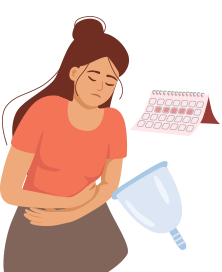Menstrual Health
Irregular Periods

About
Irregular periods are a common menstrual problem that affects many women. It is characterized by changes in the timing or length of menstrual cycles. Irregular periods can make it difficult to predict when your next period will occur.

Symptoms
You may experience some or all of the below symptoms if you are transiting to menopause
- Changes in the length of menstrual cycles
- Changes in the timing of menstrual cycles
- Spotting between periods
- Heavy or prolonged bleeding during periods
- Missed periods

Treatment
The treatment for irregular periods depends on the underlying cause. In some cases, no treatment may be required, and the irregular periods may resolve on their own. However, if the irregular periods are due to a medical condition, such as polycystic ovary syndrome (PCOS), thyroid disorders, or endometriosis, medical treatment may be necessary. Hormonal therapy, such as birth control pills or hormone replacement therapy, may also be prescribed to regulate the menstrual cycle. In some cases, lifestyle modifications such as maintaining a healthy weight, reducing stress, and exercising regularly can help regulate the menstrual cycle.

Risks
Irregular periods can sometimes be a sign of an underlying medical condition that requires medical attention. If left untreated, these conditions can lead to complications such as infertility, anaemia, or even cancer in some cases. Irregular periods can also make it difficult to predict ovulation, making it challenging to conceive.

Routine Checkups
It is recommended that women have regular gynaecological checkups, including pelvic exams and Pap tests, to detect any underlying medical conditions that may cause irregular periods. Women should also discuss any changes in their menstrual cycle with their healthcare provider to determine the underlying cause and appropriate treatment.
Maintaining a healthy lifestyle, eating a balanced diet, exercising regularly, and managing stress is essential to regulate the menstrual cycle and prevent irregular periods.



